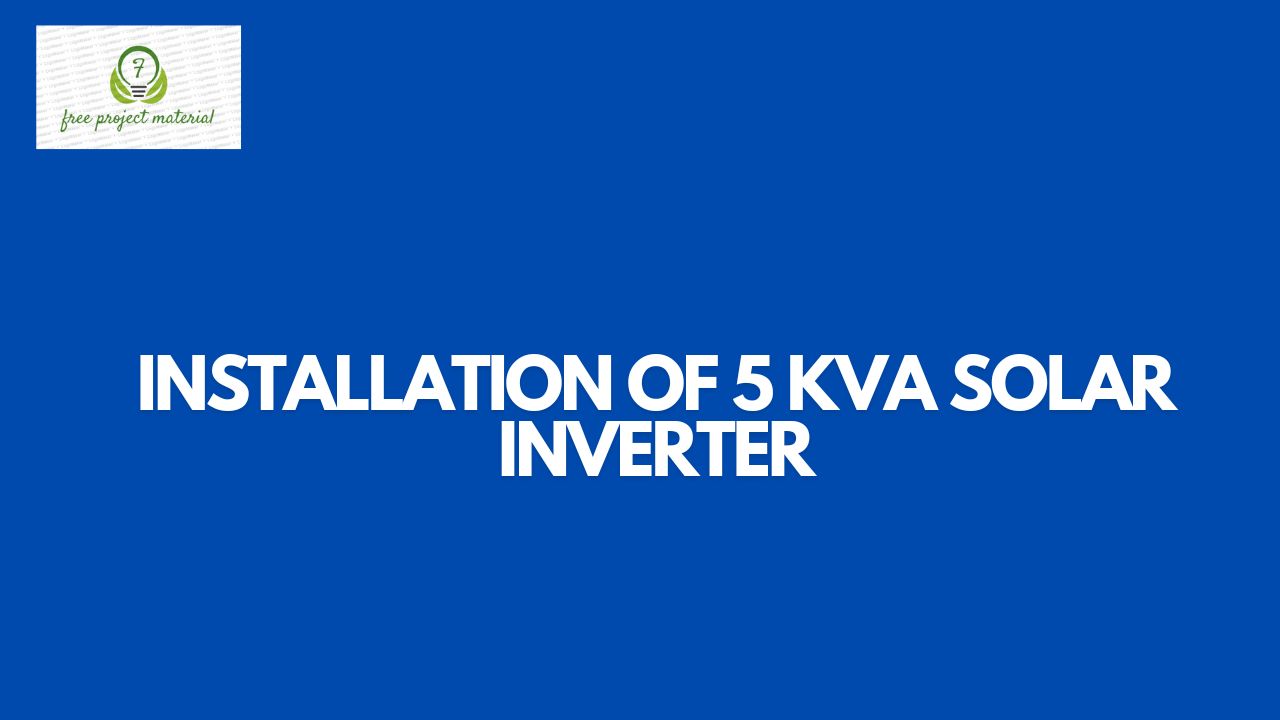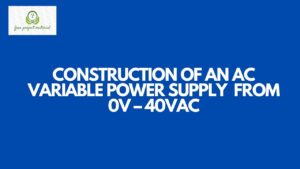ABSTRACT
This project work on installation of 5KVA solar inverter to power a building. The solar panel brings down (DC) voltage cause it directly from the sun, then the inverter convert the (DC) voltage to (AC) voltage. In this project the battery used are up to 48V that i.e. each of the solar battery has 12V. Rechargeable battery that integrates a solar cell with battery power storage, while a charge controller control is the total amount of voltage to be charged in the battery and then resulate it ot the system. Also the National Grid (main supply) charge the solar battery when there is a grid supply. This system use two sources to charge the battery. While the inverter is a device that converts direct current (DC) generated from the solar panel to alternating current (AC) electricity which is used by the load. While a load refers to the power consumption of the devices that are being used in the system. The solar panel are eight in numbers and each of the solar panel has 360 watt. Being fed to the charge controller to charge the solar battery. The inverter then used the photovoltaic source to drive the load at home or offices. When the National grid comes in, the inverter can automatically switen to the grid supply and when the supply is OFF, the solar battery will automatically switch ON to supply the load in the building.
TABLE OF CONTENTS
Cover Page – – – – – – – – i
Declaration – – – – – – – – ii
Certification – – – – – – – iii
Dedication – – – – – – – – iv
Acknowledgement – – – – – – v
Abstract – – – – – – – – vi
Table of Contents – – – – – – – vii
List of Figures – – – – – – – ix
List of Tables – – — – – – – x
CHAPTER ONE: INTRODUCTION
1.1 Background of the Study- – – – – 1
1.2 Statement of the Problem- – – – – 3
1.3 Aim/Objective of the Study – – – – 4
1.4 Significant of the Study – – – – – 5
1.5 Scopes/Limitations of the study – – – 5
1.6 Organization of the Project- – – – – 6
CHAPTER TWO: REVIEW OF RELATED LITERATURE
2.1 Historical Background of the Study – – – 7
2.1.1 Inverter – – – – – – – 8
2.1.2 Solar Battery – – – – – – 9
2.2 Benefits of an Hybrid Solar System – – – 10
CHAPTER THREE: METHODOLOGY
3.1 Materials Used- – – – – – – 12
3.2 Block Diagram – – – – – – 18
3.3 Wiring/Installation Diagram – – – – 19
3.4 Installation Procedure – – – – – 20
CHAPTER FOUR: RESULT AND DISCUSSION
4.1 Performance Test – – – – – – 25
4.2 Area of Application- – – – – – 26
4.3 Maintenance- – – – – – – 30
4.4 Costing- – – – – – – – 31
CHAPTER FIVE: SUMMARY, CONCLUSION AND RECOMMENDATION
5.1 Summary – – – – – – – 33
5.2 Conclusion – – – – – – – 33
5.3 Recommendation – – – – – – 34
References
Appendix
LIST OF FIGURES
Figure 3.2: A block Diagram showing a wiring of 5 KVA
solar inverter system- – – – – – 18
Figure 3.3: Wiring Installation Diagram- – – – – 19
Figure 4.1: Output of Oscillator- – – – – – 26
Figure 4.1.2 Oscillator/MOSFET Output- – – – – 27
LIST OF TABLES
Table 4.3.6: Change Over State- – – – – 28
Table 4.1.7: Shows the Output Voltage of the Inverter
and Battery Voltage of Varying Loads- – 29
Table 4.1.9 Test and Result- – – – – – 30
CHAPTER ONE
INTRODUCTION
1.1 BACKGROUND OF THE STUDY
The PV/Solar energy which is produced from the power and heat of the sun’s rays and could be converted into electricity, is renewable, free and infinite. Hence, it will not run out, unlike conventional energy sources.
In comparison with other energy sources, solar energy has the least negative impact on the environment. It does not release many harmful emission or other heat-trapping gases into the air that contribute to climate change so, it is environmentally friendly.
The growth of solar power adoption has been happening so fast. Nowadays the percentage of solar energy production is over 1 % of the total energy production in the world. According to the international energy agency study in 2014, solar energy production could contribute 27 % of global electricity generation by 2050. This figure seems to be very encouraging to start investing in solar energy.
A solar cell panel, solar electric panel, photo-voltaic (PV) module or solar panel is an assembly of photovoltaic cells mounted in a framework for installation. Solar panels use sunlight as a source of energy to generate direct current electricity. A collection of PV modules is called a PV panel, and a system of PV panels is called an array. Arrays of photovoltaic system supply solar electricity to electrical equipment.
Solar systems are made up of solar panels (modules), a mounting system and a solar inverter with computerized controller. Solar panels produce DC electricity from sunlight. Then the inverter converts the generated electricity into AC, so that it can be used in the household. The computerized controller manages the solar system and ensure optimal performance. If you want battery backup system or an off-the-grid solar system, a battery is required.
The most common location for the installation of solar system panels is the roof. Most roofs typically have the desired specifications for the installation, so that panels get the maximum sunlight.
Nevertheless, if installation on the roof is not applicable or desired, the solar panels could also be mounted on the ground. You just need to make sure that there are no objects blocking access to the sun.
Solar panel installation guide is a step by step process which includes; mounting of installation, installing the solar panel, doing the electrical mounting, connecting the system to solar inverter, connecting solar inverter and solar battery, connecting solar inverter inverter to the grid and staring the solar inverter.
1.2 Statement of the Problem
The epileptic power supply in Nigeria has resulted in lack of adequate electricity in most homes, businesses and institutes, which affects the consumer of power in that region.
Taking into consideration an average Nigerian home or business outlet, the common appliance used is the refrigerator for food preservation, fans and air conditioners for cooling during sunny days, television, computers and printers, among others. These appliances mentioned are used most of the time by an average Nigerian but it clearly shows that the electricity ON time needed for the normal day-to-day operation of the loads are seriously hindered due to the inefficiency of the power sector in Nigeria. Similarly, the exponential increase in electricity tariff is undoubtedly appalling.
As a result of this, people tend to solve these problems by the use of mechanical generators. These have equally proven beyond doubts to be ineffective due to high running cost and maintenance. The day-to-day maintenance of the several existing power supply devices is fast becoming unbearable. Also, the daily emissions being generated by these conventional electricity suppliers leads to Ozone Layer depletion, which invariably result in Green House effect, thereby causing climate change. They also constitute both air and sound pollutions, which portray serious hazards to the environment.
The above outlined problems have made the teeming consumers to become independent of the national grid as well as the conventional power devices, thereby making them to opt for an alternative means of electricity supply.
1.3 Aim/Objectives of the Study
To install hybrid power supply to domestic appliances and also generate a stable source of power.
Objectives
- To avoid noise in the surrounding which is produced by gasoline engines such as diesel and petrol generators.
- To save cost of fueling and maintenance of gasoline engine generators
- To ensure that there is continuous power supply
- To reduce damage of electronic appliances as a result of a fluctuating and unstable power supply.
1.4 Significant of the Study
It is worthy to note, the importance of an “Hybrid Inverter” which was carried out as a project in this department.
Hybrid Inverter does not only invert a Direct Current back to Alternating Current, it does not only allow Alternating Current to pass through it to load when the (DC) is cut off. Hybrid Inverter does a careful logical checks and compare which source it should sent to the output at a time.
It charges the battery separately while in-used. Its sensitivity faults, surge and overload cannot be overemphasized.
Hybrid Inverter are gradually taking over the market as a normal inverters are facing out.
1.5 Scopes and Limitations
The solar inverter system was install for load not exceeding 5KVA, pure sine wave at 240V, 50 using PICI6F877 with a 24v/200AH battery in the electrical electronic department.
This Hybrid Inverter cannot support a load that consumes power which exceeds the rated power.
1.6 Organization of Study
- The quest to improve maintenance and management of PV systems.
- High initial cost of PV installation.
- Failure of most project on PV system within a short duration.
- The need to enhance the life-span of PV system installations.


